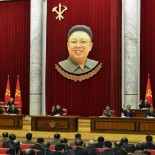Gen. Kim Yong Chol
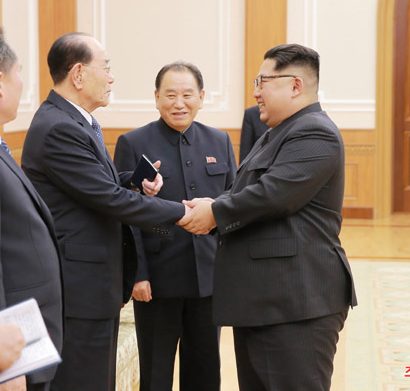
Kim Yong Chol (center) looks on as Kim Jong Un shakes hands with DPRK head of state Kim Yong Nam in February 2018 (Photo: KCNA).
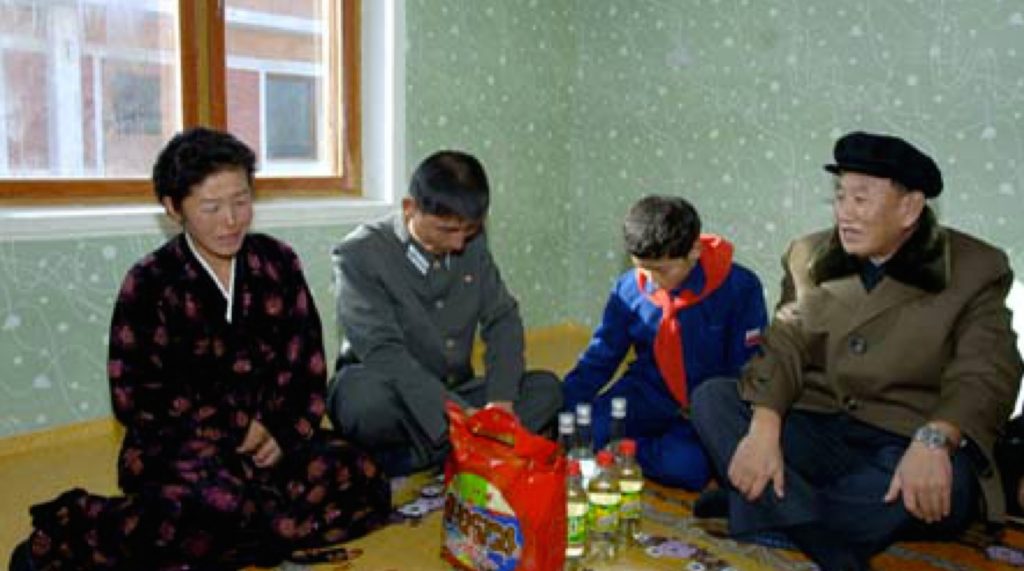
Kim Yong Chol visits with a family in their apartment in November 2016 (Photo: Rodong Sinmun).
updated 22 February 2018
Kim Yong Chol (Kim Yo’ng-ch’o’l)is the Workers’ Party of Korea [WPK] Vice Chairman for South Korean Affairs and Director of the WPK United Front Department. In that position he is responsible for the daily management and administrative affairs of the WPK Central Committee’s #3 Office Complex which is involved in inter-Korea relations policy formulation, intelligence collection and analysis and information operations involving South Korea. He is also a member of the WPK Political Bureau, the DPRK State Affairs Commission, the WPK Central Committee, the WPK Central Military Commission and a deputy to the Supreme People’s Assembly [SPA] where he is a member of the SPA Presidium (standing committee). This combination of positions in the party and state makes Kim one of the most powerful figures in North Korea. Kim has served as a senior manager in the DPRK’s intelligence community for nearly 30 years.
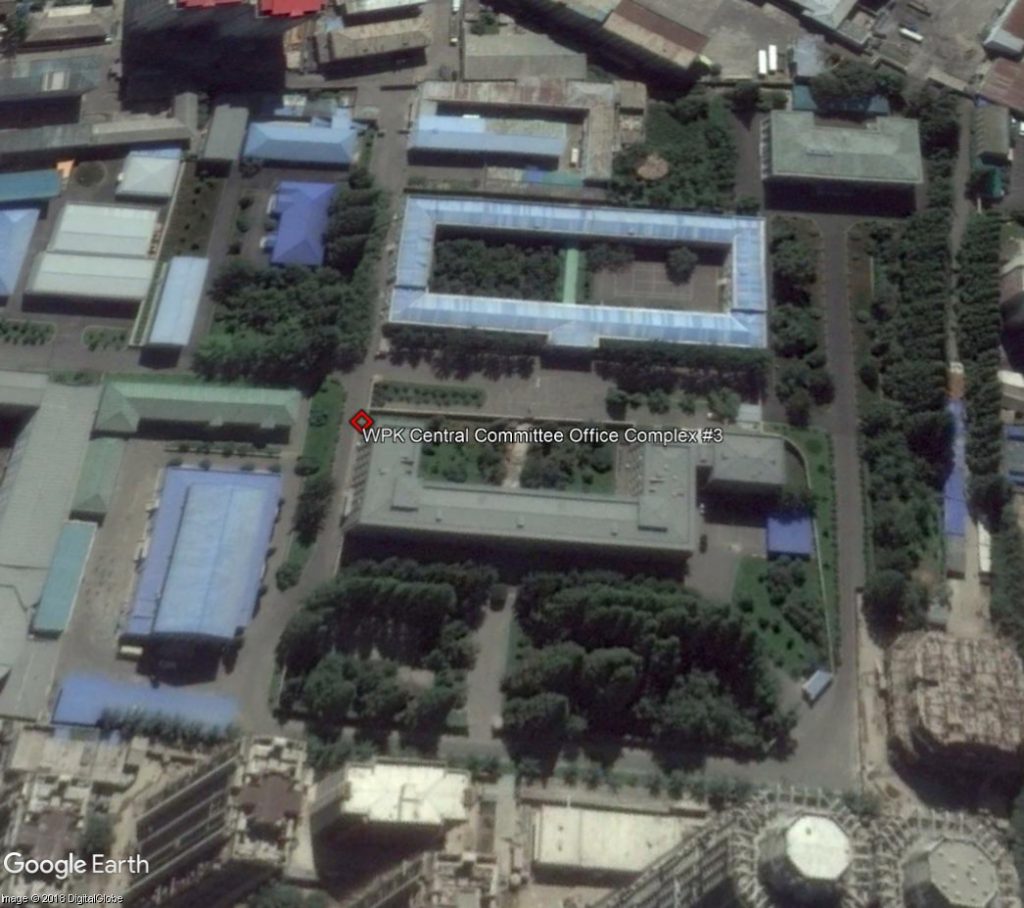
The WPK Central Committee #3 Office Complex
Kim began his career in a military police unit at the DMZ. He was a member of the Guard Command and a former bodyguard of late leader Kim Jong Il (Kim Cho’ng-il). He later held several positions linked to the inter-Korea border and DMZ. He was promoted to Lieutenant General in 1990. In the 1990s Kim Yong Chol became the first deputy director of the defense ministry’s (MPAF) reconnaissance bureau. Throughout his career, going back to the early 1990’s, Kim has also served as one of the public faces of the Korean People’s Army in state media and the country’s foreign relations.
He was elected a deputy (delegate) to the 10th Supreme People’s Assembly in 1998. In the 1990s and 2000s Kim participated in numerous inter-Korea/North-South meetings. He advocated for the DPRK’s restriction of inter-Korean border crossings in 2008 and conducted inspections near Kaeso’ng in 2009. In February 2009 Kim Yong Chol was appointed director of the Reconnaissance General Bureau (equivalent to the US Director of Central Intelligence). The RGB consolidated several DPRK intelligence agencies during late 2008 to early 2009 including intelligence collection along with direction of training and operations.
As head of the RGB, Kim Yong Chol was responsible for the National Defense Commission’s [NDC] Policy Department which commanded the KPA Mission to P’anmunjo’m and formulated policy and conducted public affairs operations on behalf of the DPRK’s military intelligence community. During his tenure at the RGB, Kim oversaw the expansion of the DPRK’s cyber and electronic warfare and defense units and was rumored to have a planning and command role in the March 2010 sinking of ROK naval corvette Cheonan. The RGB was also involved in several foreign collection missions and special activities, including a botched assassination attempt on senior DPRK defectors residing in South Korea.
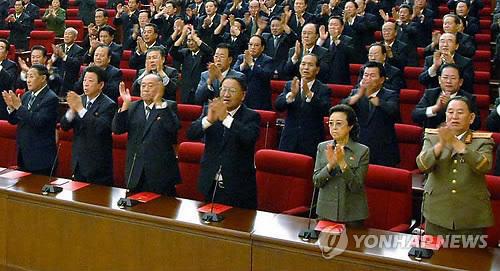
Kim Yong Chol (R) and Kim Kyong Hui (2nd R) attending the 3rd Party Conference in September 2010 (Photo: KCNA-Yonhap)
During 2009 and 2010, Kim was one of a half-dozen senior KPA commanders who accompanied then-hereditary successor Kim Jong Un [Kim Cho’ng-u’n] on inspection tours and briefings at military units. Kim Yong Chol was elected to full membership on the WPK Central Committee and a member of the WPK Central Military Commission. during the 3rd Party Conference on 28 September 2010. During the 3rd Party Conference he was seated next to Kim Kyong Hui (KJU’s aunt and sister of Kim Jong Il) and two places over from Jong Un, then making his mass public debut as successor.

Kim Jong Un (2nd R) looks through binoculars across the DMZ into South Korea during an inspection of sites in and around Panmunjom. Also in attendance is Gen. Pak Jae Gyong (L) and Gen. Kim Yong Chol (R). Since 2009 Gen. Kim has managed military intelligence operations against South Korea. Closely linked to Kim Jong Un’s succession, he was promoted to 4-star general in February 2012. (Photo: KCNA)
On 15 February 2012 Kim was promoted to a 4-star General. He was reported and photographed accompanying Kim Jong Un on several visits, including a March 2012 visit to P’anmunjo’m. He was temporarily demoted one-star to Colonel General in 2012, but restored in February 2012. On 5 March 2013 Kim Yong Chol appeared in state media as a spokesman for the KPA Supreme Command which threatened that the DPRK would disregard the armistice agreement. Kim subsequently attended Kim Jong Un’s inspection of units along the North Limit Line [NLL] and other forward deployed units on the inter-Korean in March 2012.

Kim Yong Chol delivering a statement in 2013 in his capacity as KPA Reconnaissance General Bureau Director and Vice Chief of the KPA General Staff (Photo: KCNA).
On 7 April 2013, after the DPRK announced it could not guarantee the safety of diplomatic personnel and foreign nationals, Kim Yong Chol held a meeting with foreign ambassadors stationed in Pyongyang, which was subsequently leaked by South Korean government officials. According to a South Korean government source who spoke to Yonhap News Agency, during the meeting, “nobody at the embassies stationed in the North said general Kim told them to leave the country (on Sunday) according to our confirmation via diplomatic channels.”
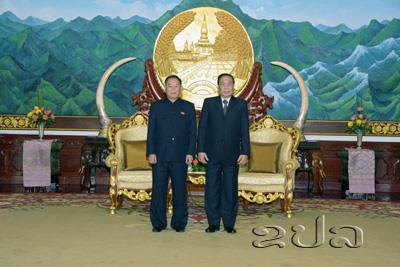
Kim Yong Chol (left) poses for a commemorative photo with Lao President Choummaly Sayasone (right) in Vientiane on February 12, 2016 (Photo: KPL).
In January 2016, Kim Yong Chol migrated from the military to the party apparatus and became the director of the WPK United Front Department [UFD], the DPRK’s lead ministerial-level organization which serves as a combination civilian intelligence agency and foreign ministry for the North’s relations with South Korea. During the 7th Congress of the Workers’ Party of Korea [WPK], Kim was elected to the 7th Central Committee. He was subsequently elected WPK Vice Chairman (for South Korean) Affairs, a member of the WPK Central Military Commission and Director of the WPK United Front Department.
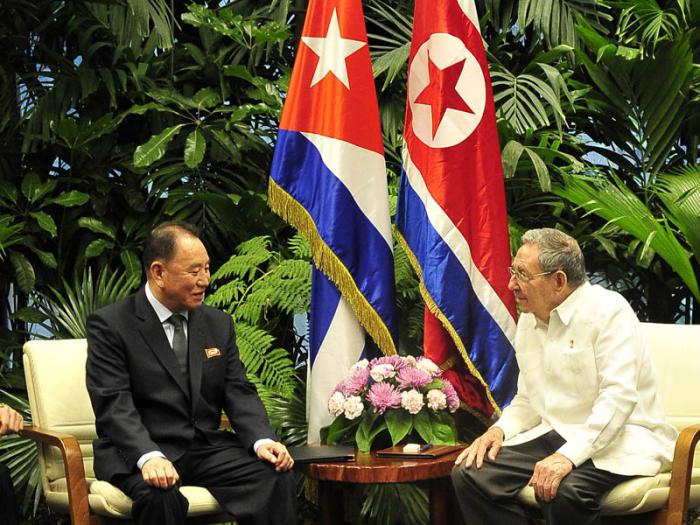
Kim Yong Chol meets with Cuban leader Raul Castro in May 2016
During Kim Yong Chol’s tenure at UFD he has overseen a corporate restructuring process in the DPRK’s organizations that deal with the south, culminating in increasing “secret contacts” with ROK interlocutors and the DPRK sending its first high level delegation to the ROK in three years. At the 4th session of the 12th Supreme People’s Assembly, Kim was elected to the SPA Presidium (or standing committee), an organization which makes recess personnel appointments and policy decisions between convocations of the full SPA. Kim’s appointment was done in his capacity as the DPRK’s lead official on inter-Korea relations.
Kim has a reputation of being difficult to work with and for not being properly deferential to his superiors. During his tenure at the RGB in the late 2000s, his superior Gen. O Kuk Ryol [O Kuk-yo’l] became so frustrated with Kim that he said “I shall have to put my hand to him.” In actuality, Kim Yong Chol can be quite sarcastic and exhibits what would be called snark. At inter-Korea military talks in 2007, he made several dark jokes which is ROK counterparts didn’t understand. At another meeting with South Korean officials, Kim Yong Chol rejected what the ROK had offered and said “Do you have another briefcase with you? Maybe you have another briefcase of proposals.”
Kim Yong Chol was born in 1945. He attended the Mangyo’ngdae Revolutionary School and Kim Il-so’ng Military University. The early portion of his career enjoyed the patronage of the late VMar Jang Song U [Chang So’ng-u] (1935-2009), a close adjutant to Kim Jong Il. VMar Jang ensured that Kim Yong Chol was promoted and held command positions when Kim was in the Guard Command, and also introduced him to KJI. Kim developed a close relationship with KJI and members of the Kim Family, including KJI’s fourth wife, Ko Yong Hui [Ko Yo’ng-hu’i], mother of Kim Jong Un. Kim Yong Chol is a polyglot, who fluently speakers several languages in addition to Korean. He is highly intelligent, a competent manager and administrator and is not corrupt.
Kim Yong Chol
WPK Vice Chairman
KPA General
Director, WPK United Front Department
Member, WPK Political Bureau
Member, WPK Central Military Commission
Member, State Affairs Commission
Member, Supreme People’s Assembly Presidium
Member, 7th WPK Central Committee
Deputy, 13th Supreme People’s Assembly
1962: 15th Division (DMZ Civil Police Company)
1968: Liaison Officer, Military Armistice Commission
1976: Division Commander, Guard Command
1990: Promoted, Major General
Deputy Director, MPAF
Director, MPAF Reconnaissance Bureau
1998: Deputy, 10th SPA
2003: Deputy, 11th SPA
2004: Promoted, Lieutenant General
2009: Director, NDC Reconnaissance General Bureau
Vice Chief of the KPA General Staff
Deputy, 12th SPA
2010: Elected, Member, CMC
Elected, Member, 6th WPK Central Committee
Promoted, Colonel-General
Member, Jo Myong Rok Funeral Committee
2011: Kim Jong Il Funeral Committee
2012: Promoted, General
2014: Elected, Deputy, 13th SPA
Member, Jon Pyong Ho Funeral Committee
2015: Member, Ri Ul Sol Funeral Committee
Member, Kim Yang Gon Funeral Committee
2016: (May) Elected, 7th WPK Central Committee
Elected, WPK Political Bureau Member
Elected, WPK Central Military Commission
Elected, WPK Vice Chairman
Appointed, WPK United Front Department Director
Member, Kang Sok Ju Funeral Committee
(June) Elected, SPA Presdium Member
(November) Member, Ryu Mi Yong Funeral Committee
See also:
Joseph S. Bermudez Jr., “A New Emphasis on Operations Against South Korea,”38 North, U.S.-Korea Institute at SAIS, Johns Hopkins University, June 11, 2010. Online at:www.38north.org/?p=920.
Kim So-hyun, “Kim Visits Army Unit Spying on S. Korea,” Korea Herald, April 27, 2010
“Who’s Who in N. Korea’s Powerful National Defense Commission,” Chosun Ilbo, June 1, 2010
Yonhap News Agency. North Korea Handbook. Armonk, NY: ME Sharpe, 2003. p. 858
“Let the Hawks Soar!” by Michael Madden, 38 North, US-Korea Institute at SAIS, Johns Hopkins University, February 25, 2016 <https://www.38north.org/2016/02/mmadden022516/>
